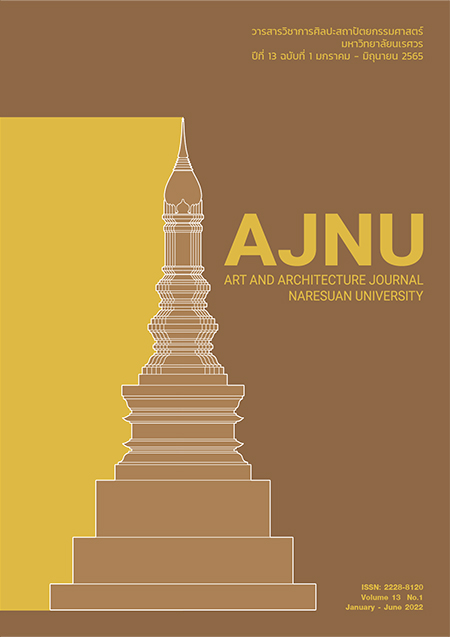The study of texture case for creative relief printing using collagraph technique
Main Article Content
Abstract
This study of surface texture for creative collagraph printmaking aimed (1) to examine fabric texture, and (2) create collagraph printing. Fabrics, 75 samples for trial printing, were randomly selected from stores in Muang, Pattani. The results showed that fabric provides different texture of its weight. Different roughness provides surface weigh differently. These surface differences are due to density and pattern of fiber in each direction - diagonal and cross-hatched pattern. Lace fabrics give sense of beauty and distinction in its design, while knitted fabrics provide fluffy and vague texture which is suitable for making image background. Some fabrics were easily tested for printing because of their thinness. The collagraph printing trials were selected by experts and analyzed for sticking of color. The results of texture and visual element of art of fabric patterns showed various features including roughness, fineness, ruggedness, line, weight, and shape, which gave a sense of personality derived from the collagraph printing with distinct and various features of surface. The variety of fabric textures can be categorized into four groups: 1) low and high key texture, 2) line texture, 3) geometric and free texture, and 4) floral and leaf design texture. In the making process of collagraph printing, to define patterns and overlay printing techniques. The collagraphs were categorized into three different surface texture of printmaking including 1) composition using overall intensity of surface weight, 2) composition using geometry and independent texture, and 3) composition using flora textures.
Article Details

This work is licensed under a Creative Commons Attribution-NonCommercial-NoDerivatives 4.0 International License.
References
จิราพร เกิดแก้ว. (2558). การศึกษาผ้าชนิดต่าง ๆ ด้วยเทคนิค ATR-FTIR, TGA และ DSC เพื่อประโยชน์ทางนิติวิทยาศาสตร์. วท.ม.,มหาวิทยาลัยศิลปากร,นครปฐม. สืบค้นเมื่อ 21 เมษายน 2563, จาก http://202.44.135.157/ dspace/bitstream/ 123456789/284/1/%e0%b8%88%e0%b8%b4%e0 %b8%a3%e0%b8%b2%e0%b8%9e%e0%b8%a3.pdf
ธนเดช วรวงษ์. (2557). ศิลปะภาพพิมพ์ช่องฉลุ. Journal Art Klong Hok, 100-123. สืบค้นเมื่อ 21 เมษายน 2563, จาก http://www.journal.rmutt.ac.th:8080/index.php/arts/article/download/291/293.
ปัทมพร ทนันชัยบุตร. (2548). ทำความรู้จักภาพพิมพ์แกะไม้. วารสารศูนย์บริการวิชาการ, 13(3), 32-38.
ราชบัณฑิตยสถาน. (2541).พจนานุกรมศัพท์ศิลปะ ฉบับราชบัณฑิตยสถาน. กรุงเทพฯ, 129-131.
ผกามาศ สุวรรณนิภา. (2563). เส้นใยในงานศิลปะ. วารสารศิลปกรรมบูรพา. สืบค้นเมื่อ 21 เมษายน 2563, จาก https://so01.tci-thaijo.org/index.php/buraphaJ/article/download/244139/165454.
สมศิริ อรุโณทัย. (2559). การวาดเส้นสร้างสรรค์: ภาพพิมพ์. วารสารวไลอลงกรณ์ปริทัศน์ (มนุษยศาสตร์และสังคมศาสตร์), 3(3), 161-174.
สายชล มงคล. (2554). การศึกษาชนิดของผ้าที่มีผลต่อวิธีการเย็บวงแขนเสื้อ. คศ.ม. มหาวิทยาลัยเทคโนโลยีราชมงคลธัญบุรี, ปทุมธานี, สืบค้นเมื่อ 18 มีนาคม 2563, จาก http://www.repository.rmutt.ac.th/dspace/bitstream/123456789/ 789/1/124355.pdf
สี แสงอินทร์. (2557). ภาพองค์ประกอบศิลป์: กรณีศึกษาเทคนิคการสร้างงานศิลปะภาพพิมพ์ครั้งเดียว โดยใช้แผ่นพลาสติกรองพื้น. วารสารวิจิตรศิลป์, 5(1), 205-236.


